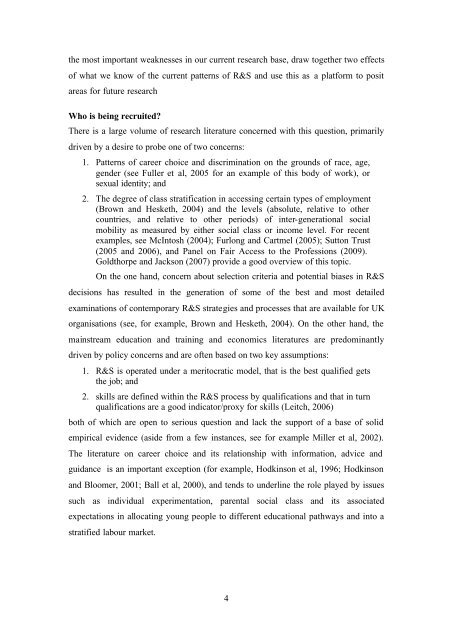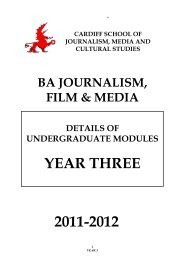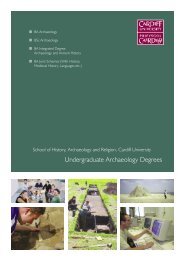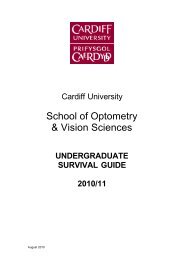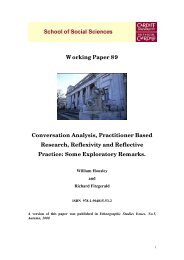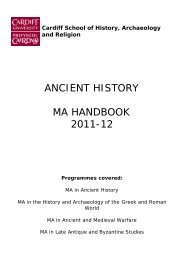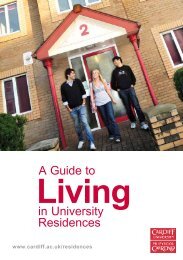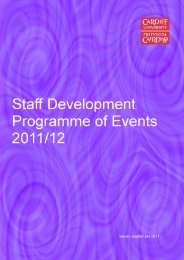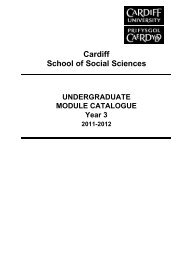Recruitment and Selection â the Great Neglected ... - Cardiff University
Recruitment and Selection â the Great Neglected ... - Cardiff University
Recruitment and Selection â the Great Neglected ... - Cardiff University
Create successful ePaper yourself
Turn your PDF publications into a flip-book with our unique Google optimized e-Paper software.
<strong>the</strong> most important weaknesses in our current research base, draw toge<strong>the</strong>r two effects<br />
of what we know of <strong>the</strong> current patterns of R&S <strong>and</strong> use this as a platform to posit<br />
areas for future research<br />
Who is being recruited?<br />
There is a large volume of research literature concerned with this question, primarily<br />
driven by a desire to probe one of two concerns:<br />
1. Patterns of career choice <strong>and</strong> discrimination on <strong>the</strong> grounds of race, age,<br />
gender (see Fuller et al, 2005 for an example of this body of work), or<br />
sexual identity; <strong>and</strong><br />
2. The degree of class stratification in accessing certain types of employment<br />
(Brown <strong>and</strong> Hesketh, 2004) <strong>and</strong> <strong>the</strong> levels (absolute, relative to o<strong>the</strong>r<br />
countries, <strong>and</strong> relative to o<strong>the</strong>r periods) of inter-generational social<br />
mobility as measured by ei<strong>the</strong>r social class or income level. For recent<br />
examples, see McIntosh (2004); Furlong <strong>and</strong> Cartmel (2005); Sutton Trust<br />
(2005 <strong>and</strong> 2006), <strong>and</strong> Panel on Fair Access to <strong>the</strong> Professions (2009).<br />
Goldthorpe <strong>and</strong> Jackson (2007) provide a good overview of this topic.<br />
On <strong>the</strong> one h<strong>and</strong>, concern about selection criteria <strong>and</strong> potential biases in R&S<br />
decisions has resulted in <strong>the</strong> generation of some of <strong>the</strong> best <strong>and</strong> most detailed<br />
examinations of contemporary R&S strategies <strong>and</strong> processes that are available for UK<br />
organisations (see, for example, Brown <strong>and</strong> Hesketh, 2004). On <strong>the</strong> o<strong>the</strong>r h<strong>and</strong>, <strong>the</strong><br />
mainstream education <strong>and</strong> training <strong>and</strong> economics literatures are predominantly<br />
driven by policy concerns <strong>and</strong> are often based on two key assumptions:<br />
1. R&S is operated under a meritocratic model, that is <strong>the</strong> best qualified gets<br />
<strong>the</strong> job; <strong>and</strong><br />
2. skills are defined within <strong>the</strong> R&S process by qualifications <strong>and</strong> that in turn<br />
qualifications are a good indicator/proxy for skills (Leitch, 2006)<br />
both of which are open to serious question <strong>and</strong> lack <strong>the</strong> support of a base of solid<br />
empirical evidence (aside from a few instances, see for example Miller et al, 2002).<br />
The literature on career choice <strong>and</strong> its relationship with information, advice <strong>and</strong><br />
guidance is an important exception (for example, Hodkinson et al, 1996; Hodkinson<br />
<strong>and</strong> Bloomer, 2001; Ball et al, 2000), <strong>and</strong> tends to underline <strong>the</strong> role played by issues<br />
such as individual experimentation, parental social class <strong>and</strong> its associated<br />
expectations in allocating young people to different educational pathways <strong>and</strong> into a<br />
stratified labour market.<br />
4


